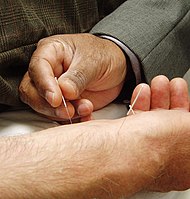
Photo from wikipedia
Subarachnoid hemorrhage (SAH), especially aneurysmal subarachnoid hemorrhage, is a serious cerebrovascular disease with high mortality and morbidity. However, there is no effective treatment in clinics. In recent years, more and… Click to show full abstract
Subarachnoid hemorrhage (SAH), especially aneurysmal subarachnoid hemorrhage, is a serious cerebrovascular disease with high mortality and morbidity. However, there is no effective treatment in clinics. In recent years, more and more studies have shown that early brain injury (EBI) may be an important reason for poor prognosis of SAH. Explore the mechanism of early brain injury after subarachnoid hemorrhage (SAH). In this study, 20 male New Zealand white rabbits were selected and divided into the experimental group and sham operation group, with 10 rabbits in each group. The neurobehavioral scores, food intake, and cerebral perfusion parameters, cerebral blood volume (CBV), cerebral blood flow velocity (CBF), ET-1, IL-1, and IL-6, in rabbit plasma were compared. The food intake scores and neurological dysfunction scores of the experimental group at 1 h, 6 h, 24 h, and 72 h after modeling were higher than those of the sham operation group, which had a statistical significance (P < 0.05). The dysfunction scores all showed a gradual decrease; the CBV and CBF values of the experimental group at 1 h, 6 h, 24 h, and 72 h after modeling were all lower than those of the sham operation group, which had a statistical significance (P < 0.05), and the MTT values were all higher than that of the sham operation group, which had a statistical significance (P < 0.05). The TTP values of rats in the experimental group were higher than those in the sham operation group at 6 h, 24 h, and 72 h after modeling (P < 0.05), the experimental group was in the modeling. The levels of serum ET-1, IL-1, and IL-6 at 1 h, 6 h, 24 h, and 72 h were higher than those in the sham operation group, which had a statistical significance (P < 0.05). New Zealand white rabbits can have brain perfusion volume disorder, inflammatory reaction, and cerebral vasospasm in the early stage after SAH, and brain injury can appear in the early stage.
Journal Title: Journal of Healthcare Engineering
Year Published: 2022
Link to full text (if available)
Share on Social Media: Sign Up to like & get
recommendations!